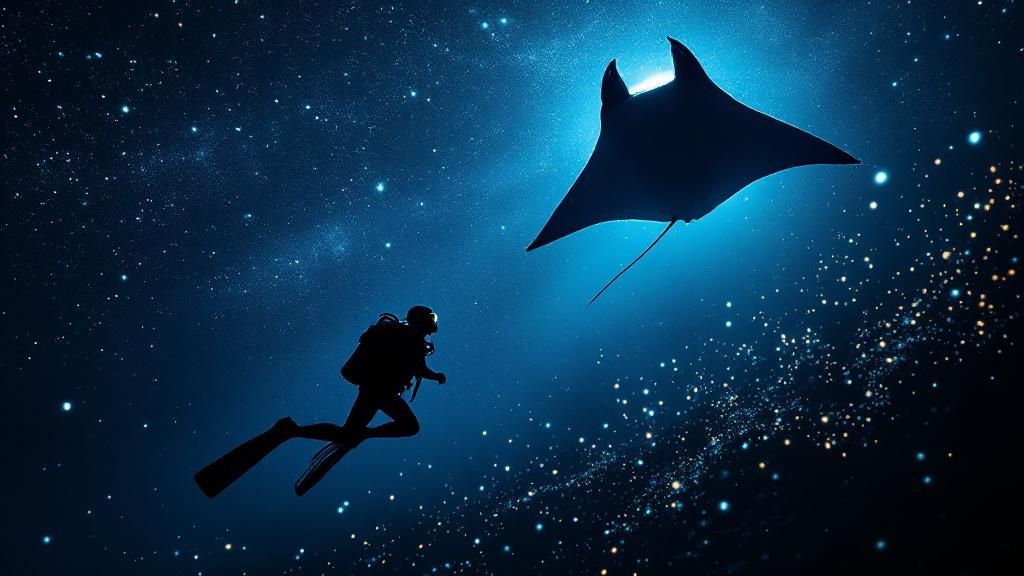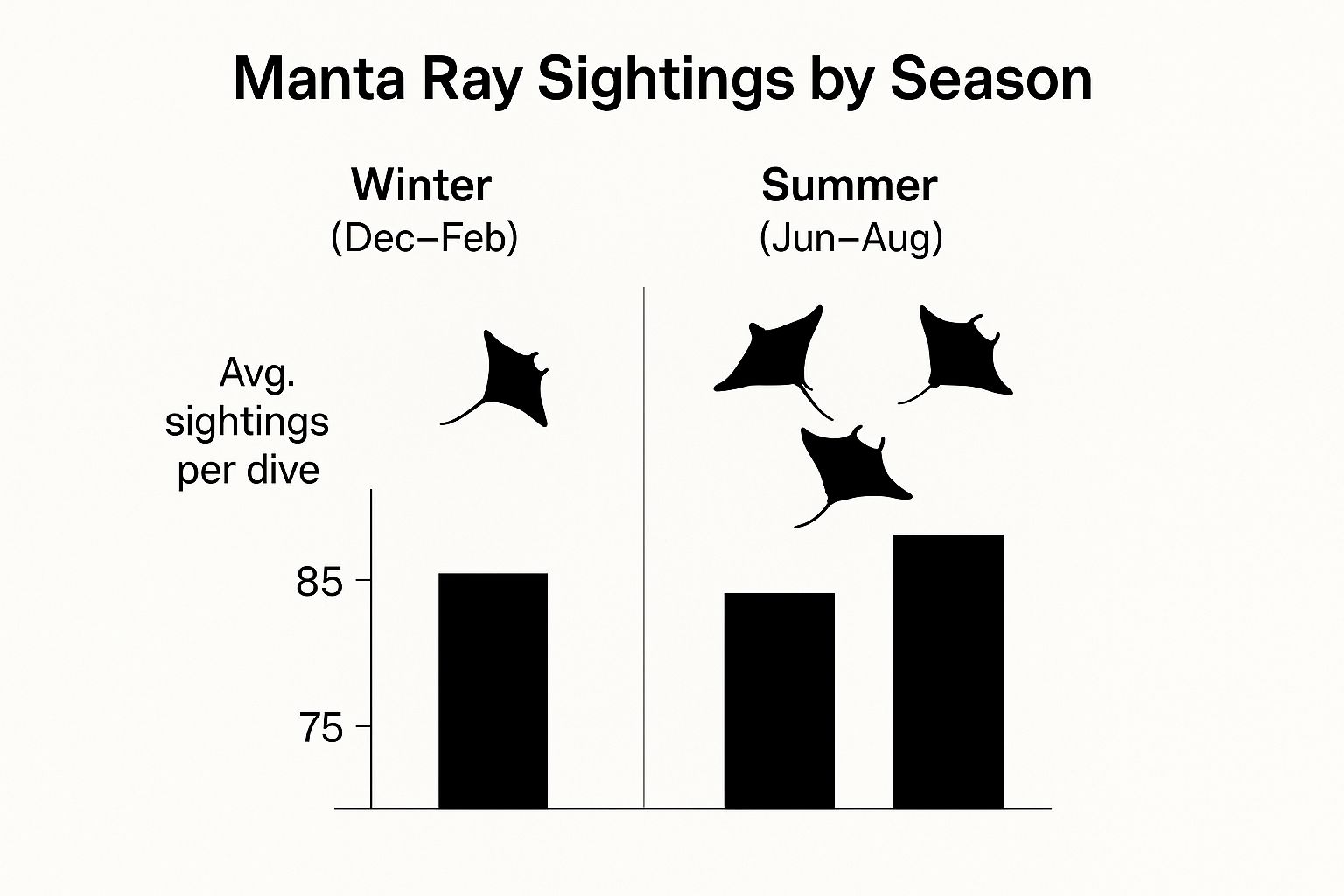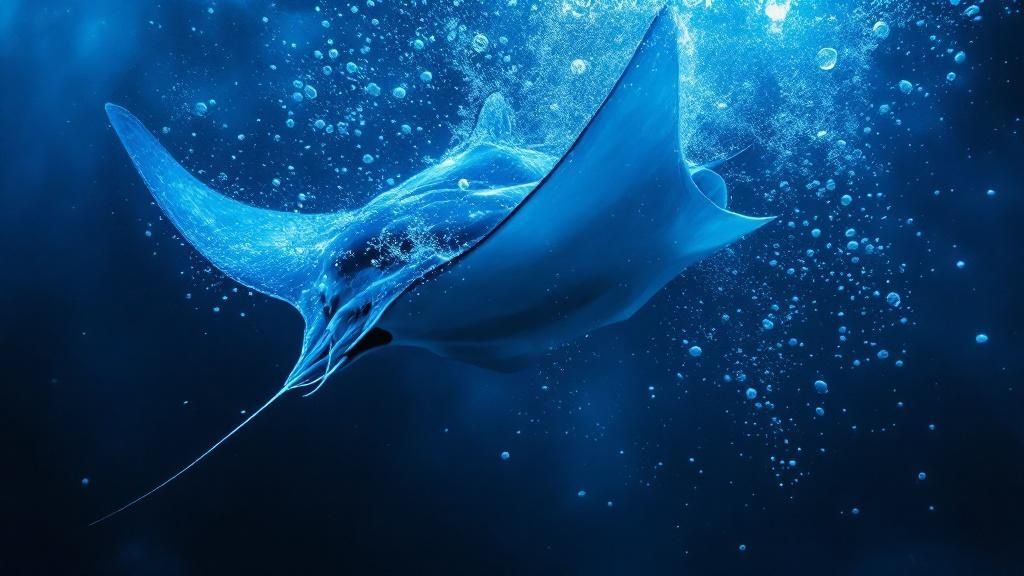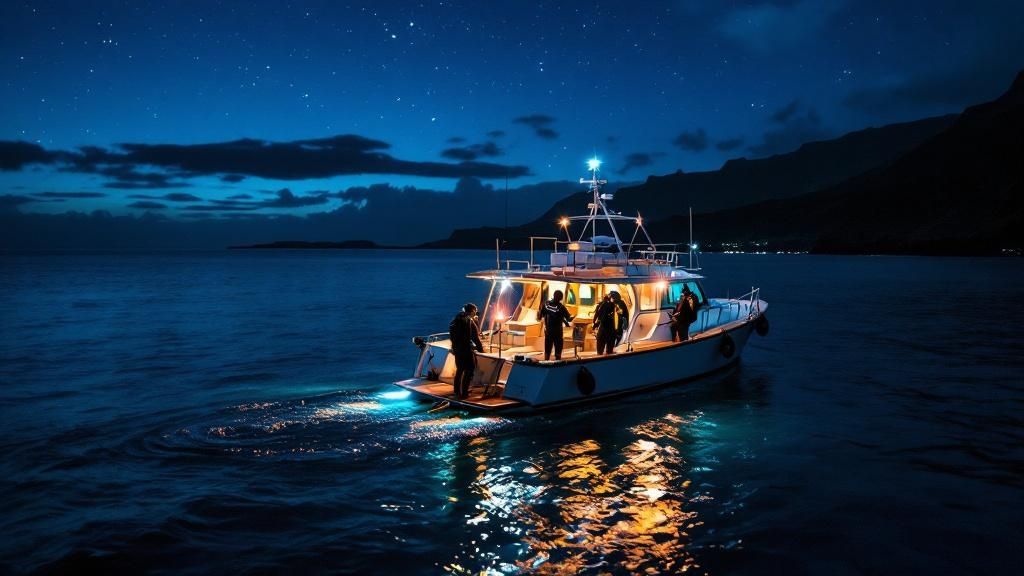Why Kona Dominates The Manta Ray Diving World
Kailua Kona, Hawaii, isn't just a beautiful vacation spot; it's the place for manta ray night dives. This isn't a coincidence. A unique combination of factors makes Kona an underwater paradise, attracting these gentle giants every night. Let's explore what makes this location so special.
The Volcanic Landscape: A Foundation For Life
The volcanic slopes defining Kona's underwater terrain are crucial to this ecosystem. They channel nutrient-rich currents upwards, fostering plankton growth. This abundance of plankton, the manta rays' main food source, is key to Kona's manta ray attraction. It's like a massive, all-you-can-eat buffet for these graceful filter feeders. You might be interested in: What is a manta ray night dive?
The Power of Plankton: An Unseen Force
Plankton, these microscopic organisms, are the base of this thriving ecosystem. Kona's unique oceanographic conditions, including stable water temperatures and currents, promote a continuous supply of these essential nutrients. This guarantees a reliable food source for the mantas, making Kona a predictable and rewarding spot for divers. The volcanic slopes also create upwellings, bringing nutrient-rich water to the surface and further boosting plankton growth. This creates a cycle, ensuring a consistent food supply for the manta rays.
One of the most compelling aspects of manta ray night dives in Kailua Kona is the high sighting frequency. On average, manta rays are seen 80-90% of the time, making Kona one of the most reliable locations for encountering these magnificent creatures. This consistency is mainly due to the unique underwater environment, which includes volcanic slopes and ocean currents that provide the perfect habitat for plankton. Find more detailed statistics here.
The Manta Ray Night Dive Experience: A Magical Dance
The magic of a manta ray night dive is enhanced by how these creatures feed. The lights used by dive operators attract plankton, and the mantas respond with beautiful underwater movements. They perform graceful barrel rolls and swooping maneuvers close to divers, creating a truly unforgettable experience. This captivating display, combined with the near-guaranteed sightings, sets Kona apart. Planning can make all the difference; find out more in How To Win Competitions 2.

Manta Village Vs Manta Heaven: Your Site Selection Guide
Choosing between Manta Village and Manta Heaven for your manta ray night dive in Kailua-Kona is an important part of planning your adventure. Both sites offer amazing chances to see these gentle giants, but each has its own distinct characteristics. Knowing these differences will help you choose the best spot for your experience level and what you want out of your dive.
Depth and Experience Level Considerations
Manta Village is known for its shallow depth, typically between 3 to 10 meters. This makes it a great choice for newer divers or those who prefer a more relaxed dive. The shallow water also means better visibility and longer bottom times, giving you plenty of time to watch the mantas. Manta ray night dives in Kailua-Kona have become very popular, with Manta Village being a favorite. Learn more about manta ray night dives. Manta Village's shallow depth makes it especially appealing to new divers or those looking for a calmer experience. The shallows enhance visibility and create a more immersive experience with the mantas gliding through the illuminated water. Manta Heaven, on the other hand, sits in slightly deeper water, making it better suited for experienced divers who are comfortable with deeper dives and potentially stronger currents.
Crowd Dynamics and Manta Behavior
Both sites attract manta rays, but the crowds and how the mantas behave are different. Manta Village often has more divers and snorkelers because it's easier to access. This concentrated light and activity can actually create a spectacular feeding frenzy, drawing in many mantas. The mantas at Manta Village are used to people and often swim very close, offering amazing interactions. You might also be interested in: Why you should go on a manta ray dive in Kona. Manta Heaven, while possibly less crowded, offers a slightly different experience. The mantas might behave more naturally as they search for food, creating a more intimate and unpredictable encounter.
Seasonal Variations and Water Temperature
The infographic below shows the average manta ray sightings and water temperatures at both sites during winter (Dec-Feb) and summer (Jun-Aug). It helps to visualize the best time to plan your dive.

As you can see, water temperatures are pretty consistent year-round, but average manta ray sightings tend to be a bit higher during the summer months at both locations. This is helpful for planning your trip and picking the best time for your manta ray night dive. Learn how to master your night dive.
The following table summarizes the key differences between Manta Village and Manta Heaven, making it easier to choose the right site for you.
Manta Village Vs Manta Heaven Comparison
A detailed comparison of the two main dive sites including depth, experience level, crowd size, and accessibility factors
| Feature | Manta Village | Manta Heaven |
|---|---|---|
| Depth | 3-10 meters | Deeper |
| Experience Level | Beginner-friendly | More experienced divers |
| Crowd Size | Often more crowded | Potentially less crowded |
| Manta Behavior | More accustomed to humans, closer interactions | More natural foraging behavior |
| Accessibility | Easier access | Requires boat access to deeper water |
Both Manta Village and Manta Heaven offer amazing manta ray encounters. The important thing is to choose the site that best fits your diving experience, comfort level, and how you'd like to interact with these incredible creatures.
Your Complete Manta Ray Night Dive Experience Unveiled

From the moment you board the boat in Kailua-Kona, excitement builds for the manta ray night dive. The journey to the dive site, whether it's Manta Village or Manta Heaven, offers beautiful views of the Kona coastline as the sun sets. This travel time allows the crew to brief you on the dive plan, safety procedures, and, importantly, manta ray etiquette.
This preparation is vital for both maximizing your enjoyment and respecting these gentle giants. Read also: Manta Ray Night Dive in the Big Island.
Entering the Underwater World
As darkness falls, you'll enter the water and descend to the designated viewing area. Divers typically settle on the sandy bottom, while snorkelers hold onto a surface float. Powerful dive lights are strategically positioned to attract plankton, the manta rays' main food source.
This creates a brightly lit feeding zone, setting the stage for a magical experience. The moment the lights pierce the darkness, the underwater world is transformed.
The Manta Ray Ballet Begins
Attracted by the abundance of plankton, manta rays appear from the shadows. Their graceful movements, often likened to a ballet, are captivating. They glide through the illuminated water, performing barrel rolls and other acrobatic maneuvers as they feed.
These gentle giants, with wingspans reaching up to 18 feet, come remarkably close, offering an exceptional chance for observation. While these dives are popular, and can be somewhat crowded, you can typically expect to see between 5 and 10 manta rays on a single dive.
This allows for a truly personal and unforgettable encounter. The convenient access to Manta Village, with many operators leaving directly from Keauhou Bay, minimizes travel time and the chance of seasickness. Explore this topic further here.
A Memorable Ascent
After about 30-45 minutes of amazing interaction, it's time to ascend and return to the boat. As you surface, you'll carry the lasting memory of these graceful creatures dancing in the dark.
The experience is often deeply moving, leaving divers with a sense of wonder and respect for the ocean. The boat ride back to shore provides a perfect opportunity to reflect on the magical encounter and discuss your experience with fellow divers. The magic of the manta ray night dive continues even out of the water, creating a shared sense of awe among those fortunate enough to witness it.
Night Diving Mastery And Manta Etiquette Essentials
Success in a manta ray night dive in Kailua Kona hinges on preparation and respect. It's more than just showing up; it's about understanding the nuances of night diving and the etiquette that makes for a magical, yet responsible, encounter. Mastering these skills will transform a potentially disappointing experience into a truly memorable one.
Buoyancy Control: Your Underwater Dance Partner
The first key to a successful manta ray night dive is buoyancy control. Imagine trying to waltz while constantly stumbling—it wouldn’t be very graceful. Similarly, maintaining neutral buoyancy is crucial in the feeding zone.
This prevents accidental contact with the mantas or the ocean floor. It also preserves the delicate ecosystem and ensures a smooth, enjoyable dive. Proper weighting and breathing techniques, for example, allow you to hover effortlessly, observing the mantas without disrupting their natural feeding patterns. This delicate dance between you and the ocean ensures both your safety and the well-being of the manta rays.
Light Etiquette: Protecting While Observing
Next, understanding light etiquette is paramount. While lights attract the plankton mantas feed on, shining a light directly into their eyes can disorient and distress them.
Instead, divers are encouraged to point their lights upwards, creating a diffused glow. This illuminates the water column without harming the mantas, allowing for optimal viewing while minimizing disturbance. Avoid constantly flashing your light, as this can also startle these graceful creatures. This careful consideration balances visibility and respect.
Positioning For The Perfect Encounter
Finally, strategic positioning enhances your manta ray viewing experience. Finding a comfortable spot on the sandy bottom and remaining still allows the mantas to approach you, sometimes coming within inches.
This patience is rewarded with up-close encounters you'll never forget. Avoid chasing the mantas, as this can disrupt their natural behavior. Let them come to you, allowing for a more natural and awe-inspiring interaction. Learn more in our article about responsible and considerate diver etiquette. This mindful approach turns your manta ray night dive in Kailua Kona into a truly magical experience.
Essential Gear And Mental Preparation
Preparing for a night dive also involves choosing the right gear. While most operators provide basic equipment, consider bringing your own mask and fins for optimal comfort and fit. A dive computer is essential for tracking depth and bottom time.
Mentally preparing yourself for the darkness and the unique environment of a night dive can also enhance your experience. Visualize the graceful mantas, the illuminated plankton, and the tranquil underwater world. This visualization can help calm any nerves and build excitement for the unforgettable encounter ahead. By combining these practical preparations with a mindful approach, you set the stage for a successful and rewarding manta ray night dive in Kailua Kona.
The Fascinating Science Behind Kona's Manta Population

The magic of a manta ray night dive in Kailua Kona isn't just a beautiful sight; it's the result of years of research and conservation. These efforts have made Kona a global model for sustainable marine tourism. This research helps us understand these gentle giants, ensuring future generations can witness the same wonder.
Unveiling Manta Mysteries Through Identification
Researchers have developed innovative identification programs to track individual manta rays. These programs use the unique spot patterns on each manta's underside, similar to a human fingerprint. This careful tracking allows scientists to study their feeding patterns, social behaviors, and overall population health.
These insights help us understand the complex lives of manta rays and their interactions with the environment. For instance, researchers can identify an individual manta's preferred feeding spots and how social dynamics affect their movements.
Kona's Dive Sites: Living Laboratories
The dive sites you'll explore during your manta ray night dive, including Manta Village and Manta Heaven, also serve as important research hubs. Researchers use these locations to gather essential data on manta ray migration routes, breeding cycles, and the impact of tourism. This real-world data is vital for creating effective conservation plans.
From 2009 to 2014, advocates conducted extensive research at these sites, often diving six to seven nights per week. This thorough data collection helped establish Kona as a prime location for consistent manta ray encounters, emphasizing the importance of these dives for both tourism and cultural value. More detailed statistics can be found here: Manta Ray Statistics. Kona's dedication to ongoing research demonstrates its commitment to responsible and sustainable manta ray tourism.
Your Dive: A Contribution to Conservation
Your manta ray night dive experience in Kailua Kona directly contributes to ongoing research. Every dive adds to the growing knowledge base that informs conservation strategies. This means that by participating in a manta ray night dive, you are actively involved in protecting these incredible creatures. You might also be interested in learning more about the best time to see these majestic creatures: What is the best time of year to see manta rays in Kona?
Responsible dive operators also educate divers about manta ray behavior and conservation, encouraging respectful interactions that minimize disturbance. This collaborative approach ensures the long-term health and sustainability of Kona's manta ray population. Through combined efforts, we can ensure the wonder of manta ray night dives in Kailua Kona continues for generations to come.
Selecting Your Perfect Manta Ray Tour Operator
Manta ray night dives in Kailua-Kona are a truly special experience. However, not all tour operators are created equal. Choosing the right one can significantly impact your adventure, transforming it from unforgettable to underwhelming. Careful research is key to ensuring you have the best possible experience.
Group Size: Intimacy vs. Crowds
The number of divers in your group plays a big role in your overall experience. Smaller groups allow for a more personal and intimate encounter with these gentle giants. Larger groups, while often more budget-friendly, can feel crowded and may even disrupt the manta rays' natural behavior.
When researching tour operators, ask about their typical group size. Look for operators who prioritize smaller groups, ideally around 6-8 divers. This ensures more personalized attention from the guide and a less intrusive experience for both you and the manta rays.
Safety Protocols: Ensuring Peace of Mind
Safety should always be your top priority. Reputable manta ray tour operators in Kailua-Kona adhere to strict safety protocols. These include experienced, certified dive guides, well-maintained equipment, and thorough safety briefings.
Don't hesitate to ask potential operators about their emergency procedures, including the availability of first aid and oxygen onboard. A commitment to safety provides peace of mind, allowing you to fully immerse yourself in the magic of the manta ray encounter.
Guide Expertise: Unlocking Deeper Insights
A knowledgeable guide can greatly enhance your manta ray dive. Experienced guides provide valuable insights into manta ray behavior, can identify individual mantas, and share fascinating information about the local ecosystem.
When choosing a tour operator, inquire about their guides' experience and PADI certifications. Guides passionate about manta rays and their environment will elevate your dive from simply seeing these creatures to truly understanding them.
Pricing and Inclusions: Understanding the Value
Prices for manta ray night dives in Kailua-Kona vary depending on the operator, group size, and what's included in the package. Some operators offer basic packages, while others may include extras like underwater photography or refreshments.
Carefully compare pricing and inclusions to avoid any surprises. Look for transparent pricing and a clear list of what's included in each package. This will help you make an informed decision based on your budget and preferences.
To help you make the best decision, we've compiled a table summarizing key factors to consider:
Before you book your tour, consider these important factors to ensure a memorable and safe manta ray diving experience. The following table summarizes key questions to ask and what to look for:
Key Factors When Choosing a Manta Ray Dive Operator
Essential criteria and questions to evaluate when selecting your manta ray night dive tour operator
| Factor | What to Look For | Questions to Ask |
|---|---|---|
| Group Size | Small groups (6-8 divers) | What is the maximum number of divers on a manta ray night dive? |
| Safety Protocols | Certified guides, maintained equipment, clear briefings | What are your emergency procedures? What safety equipment do you have on board? |
| Guide Expertise | Knowledgeable about manta rays and the local ecosystem | How long have your guides been leading manta ray dives? What certifications do they hold? |
| Pricing & Inclusions | Transparent pricing, clear inclusions | What is included in the tour price? Are there any additional fees? |
By focusing on these factors, you can select an operator who prioritizes both a high-quality experience and your safety.
Red Flags and Insider Tips: Navigating Your Options
Be aware of potential red flags when choosing a tour operator. Overcrowded boats, inadequate safety measures, and inexperienced guides can signal potential problems. Look for recommendations from trusted sources like local dive shops or online reviews.
Booking in advance, especially during peak season, is essential to secure your preferred dates. If your schedule is flexible, consider visiting during the shoulder seasons for potentially smaller crowds and more competitive pricing. These tips can help you avoid common pitfalls and maximize your chances of an unforgettable manta ray night dive in Kailua-Kona.
Maximizing Your Manta Ray Adventure Experience
Transforming your manta ray night dive in Kailua Kona from a simple dive into a truly unforgettable experience requires thoughtful planning. Optimizing each aspect, from choosing the perfect tour operator to capturing the wonder through photography, ensures a memorable and impactful encounter with these gentle giants.
Capturing the Magic: Underwater Photography and Videography
Documenting your manta ray encounter allows you to relive the magic and share it with others. Responsible documentation is key. Low-light conditions present a unique challenge, so investing in a good underwater camera with excellent low-light capabilities is essential. A red filter will significantly enhance the colors in your photos and videos.
-
Equipment Recommendations:
- High-ISO underwater camera
- Red filter for color correction
- External strobe or powerful dive light (used responsibly)
-
Technique Tips:
- Avoid flash photography as it can disturb the manta rays. Rely on ambient light and adjust your camera settings.
- Use a slow shutter speed to capture the manta rays' graceful movements.
- Get close, but maintain a respectful distance and avoid touching the animals.
Timing is Everything: Optimal Dive Times and Seasonal Variations
Manta rays grace Kona's waters year-round, but certain times offer superior viewing opportunities. Summer months (June-August) typically boast higher manta ray sightings. Winter months (December-February) can experience stronger swells, potentially impacting visibility. Checking local weather conditions and planning accordingly is crucial.
Choosing the right tour operator significantly impacts your manta ray experience. A reputable operator emphasizes sustainable practices and adheres to strict guidelines to protect the manta rays. They will also offer valuable insights into optimal dive times based on current conditions. Consider their use of shopper marketing strategies to understand their customer connection approach.
Beyond the Dive: Combining Your Kona Experience
Kailua Kona offers a treasure trove of activities beyond manta ray dives. Enhance your trip by combining your dive with other incredible Kona experiences.
- Explore Volcanoes National Park: Witness the raw power of volcanic landscapes.
- Snorkel or Dive at Kealakekua Bay: Discover vibrant coral reefs teeming with life.
- Visit a Coffee Plantation: Learn about Kona's world-famous coffee.
Extending the Impact: Conservation and Education
Your manta ray night dive is more than a personal experience; it's an opportunity to contribute to the conservation of these magnificent creatures. Support operators partnered with research organizations and actively promoting sustainable practices.
- Learn About Manta Ray Research: Many organizations conduct valuable research in Kona. Donating or volunteering your time makes a difference.
- Educate Others: Share your experience and advocate for responsible manta ray tourism.
- Support Conservation Efforts: Choose operators who prioritize the well-being of the manta rays and their environment.
By thoughtfully planning and committing to responsible tourism, you can transform your manta ray night dive in Kailua Kona into an unforgettable and impactful adventure. Experience the magic of manta rays with Kona Honu Divers! We offer expertly guided night dives, prioritizing sustainable practices and ensuring a memorable encounter with these gentle giants. Book your unforgettable adventure today.
